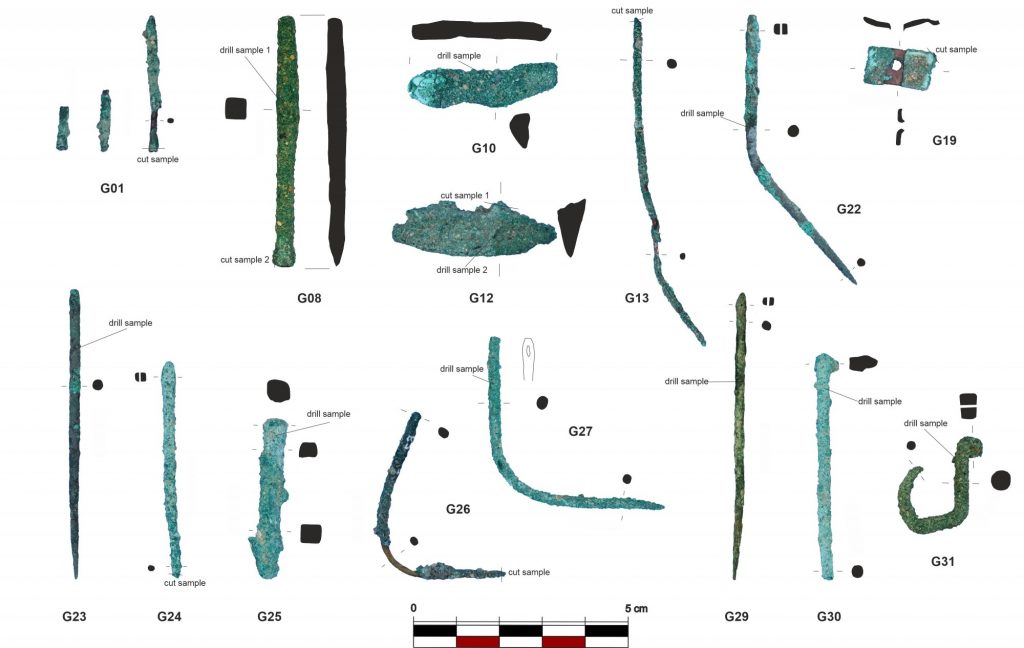There are many myths surrounding metalworking technologies from the time of the ancient Egyptian pyramid builders. The most common are that no tools have been preserved for research and that ancient Egyptians were only familiar with pure copper. Neither is correct, however: a recent study by Czech researchers, published in the renowned international Journal of Archaeological Science: Reports, enriched our knowledge of Old Kingdom metalworking technology based on archaeological material originating from Giza.

photo Martin Odler © Faculty of Arts, Charles University, Czech Institute of Egyptology
Rare tools and metalwork from Giza
The article focuses on the settlement debris from the so-called Kromer area which was first examined by Austrian archaeologists in the 1970s; their research was published in 1978. Nevertheless, the remains of tools and metalwork were not examined until a team of Czech researchers led by Dr. Martin Odler and Ing. Jiří Kmošek took a closer look. Most of the material is located in the Egyptian Museum in Cairo and cannot be sampled. However, a fraction of the corpus became part of the Study Collection of the Department of Prehistory and Historical Archaeology in Vienna managed by Dr Alois Stuppner, who made its study possible.
Artifacts from times of Egyptian Pyramid Builders
There are only a handful of artefacts in the published collection, totalling 15 items. Yet the artefacts are exceptionally rare given their original archaeological context: they were found in settlement debris while most of the other metal artefacts from the Old Kingdom come from tombs. A typological study of the artefacts proved that the collection contains, apart from a small chisel, also fragments of two large axes, two clamps, a fitting and a fishhook. Needles constitute the greater part of the collection. They are dated quite precisely because within the same deposit were found seal imprints of two pharaohs, Khufu and Khafre, the builders of the two biggest pyramids of the Fourth dynasty (approx. 2500-2450 BC) at Giza.

photo M. Odler, J. Kmošek © Faculty of Arts, Charles University, Czech Institute of Egyptology
The debris was most likely created by the removal of an older settlement at the location of Heit el-Ghurab, east of the pyramids, where an American-Egyptian team led by Mark Lehner has been stationed for several decades and where the famous “city of pyramid builders” from the time of Menkaure’s reign was found.
Chemical analysis
The study pursues a detailed analysis of the artefacts in terms of their chemical composition (neutron activation analysis), microstructures (metallography), microhardness (Vickers microhardness), and lead isotopes (ore provenance). The research proved that the larger tools in the collection, as well as their fragments, are made from arsenical copper; a material widely used in the Early Bronze Age in the ancient Near East, to which the Fourth dynasty of the Old Kingdom in Egypt is also dated.
What is arsenical copper?
Arsenical copper’s properties and hardness are similar to tin bronze, which was also known to the Egyptians, but due to its rarity they used it mainly to manufacture vessels in the Early Bronze Age. The microhardness of the preserved metal shows convenient properties for practical use, especially for wood and limestone working. An important question still left unanswered is whether they added arsenic intentionally or used ore containing both copper and arsenic.
Impure copper was identified as the material of the thinner and considerably softer needles, and their hardness was found to be variable; therefore, the technology of Ancient Egyptian metalworkers was evidently adjusted to their final products. The copper ore came from the Eastern Desert in Egypt and the Sinai Peninsula. There is also an exotic rarity in the collection, the needle G13 made from arsenical copper that contains more than three percent silver. The lead isotopes are similar to two Predynastic Egyptian artefacts from the fourth millennium BC and to litharge (lead oxide) from the Syrian site of Habuba Kabira, dated to approximately the same period. The needle, therefore, indicates the existence of ancient metal recycling related to the production of silver, which was far scarcer than gold in Ancient Egypt.

drawing M. Odler © Faculty of Arts, Charles University, Prague, Czech Institute of Egyptology
The original title of the article is Arsenical copper tools of Old Kingdom Giza craftsmen: first data by Martin Odler, Jiří Kmošek, Marek Fikrle, and Yulia V. Erban Kochergina.
You can also listen to the interview with dr Odler on History of Egypt Podcast.
This article may be freely reprinted with reference to the source. The photographs might be used if the copyright of Charles University is retained.
Authors: Martin Odler, Jiří Kmošek
About the Authors:
Martin Odler defended his PhD thesis The social context of copper in ancient Egypt down to the end of Middle Kingdom in 2020. In 2016, he published the monograph Old Kingdom Copper Tools and Model Tools‘, the first of its kind in Egyptology. In Abusir (Egypt), he led, together with Marie Peterková Hlouchová, an excavation of a new type of Egyptian tomb (AS 103) and of the latest known tomb of a transitional type from early Dynasty 4 (AS 104).
Jiří Kmošek is an archaeometallurgist, a PhD candidate at the Institute for Natural Sciences and Technology in the Arts, Academy of Fine Arts Vienna. He has analysed not only ancient Egyptian material but also Bronze Age metalwork from the Czech Republic.
Editor: J.M.C
Proofreading: Stephanie Aulsebrook
